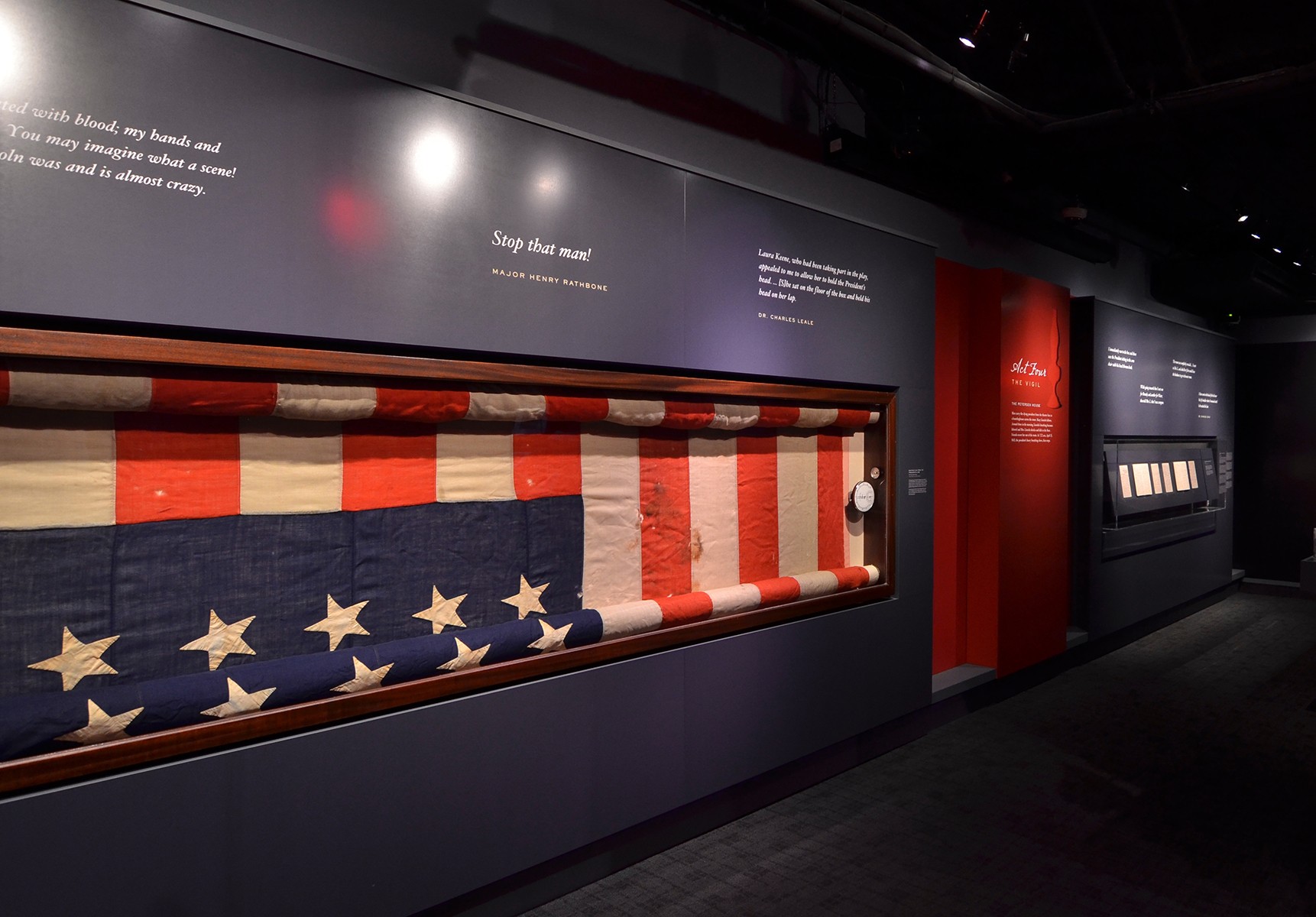
Artifact of the Assassination: The Lincoln Flag and the Gourlay Family
The subject of this month’s museum feature, the Lincoln Flag from Pike County Historical Society in Milford, Pennsylvania, gives us an opportunity to learn more about a family of actors onstage the evening of the Lincoln assassination and their role in the preservation of the flag. The Lincoln Flag can be seen in the special exhibition Silent Witnesses: Artifacts of the Lincoln Assassination through May 29, 2015.

The story of the Lincoln Flag begins on the morning of April 14, 1865, when a messenger from the White House arrived at Ford’s Theatre to request tickets for President and Mrs. Lincoln for that night’s performance of Our American Cousin. To prepare for the esteemed guests, James R. Ford, brother of theatre owner John T. Ford, visited the Treasury Department to borrow five flags with which to embellish the Presidential Box. Theatre staff also decorated the box with a framed portrait of George Washington and upholstered furniture from the Ford brothers’ office.
During the third act and at the precise moment of one of the play’s biggest laugh lines, John Wilkes Booth aimed his deringer pistol at the back of Lincoln’s head and pulled the trigger.
To examine Lincoln’s injury, doctors moved the president to the floor. The show’s star, Laura Keene, and theatre manager Thomas Gourlay had made their way to the Presidential Box with a pitcher of water for the president. Keene asked Dr. Charles Leale if she could hold the president’s head in her lap so that it would not rest on the floor. Leale granted Keene this request and she kneeled, trying to provide some comfort to the dying leader.
When Keene was ready to leave, someone—possibly Thomas Gourlay—grabbed one of the bunting flags decorating the front of the Presidential Box to put under Lincoln’s head. As Lincoln’s head rested on the flag, blood seeped from his wound, staining a section of the flag’s red and white stripes. At this moment, a regular 36-star American flag metaphorically transformed into the “Lincoln Flag” a priceless artifact of the assassination.
At the conclusion of this horrible tragedy, Thomas Gourlay kept the blood-stained flag.
The assassination affected the lives and livelihoods of all the actors present that evening, the Gourlays especially. In addition to managing that night, Gourlay also played the role of Sir Edward Trenchard in Our American Cousin. His two daughters, 20-year-old Jeannie and 16-year-old Maggie, also had roles in the play.
For Jeannie, in particular, the night’s events had a significant impact on her professional and personal life. That night, she came into direct contact with John Wilkes Booth after he leaped to the stage and fled toward the alley where his horse awaited. Directly in his path stood Jeannie and orchestra director, William Withers, who had been in whispered conversation. Booth slashed at Withers with his knife, cutting his jacket, and pushed Jeannie into some stage scenery.
This brush with the assassin and the chaotic events of the night catapulted Jeannie and Withers into an ill-fated romance that led to an engagement within 24 hours of the assassination and ended with Jeannie filing for divorce less than a year later.
But for Jeannie, the most immediate and personally disappointing result from the assassination was the closure of Ford’s Theatre. A rising actress in the Washington theatre scene, the next night’s performance was a benefit in her name. She would star in The Octoroon and all box office proceeds would go to her. With the theatre deemed a crime scene and ordered shut, Jeannie missed out on the financial and public recognition that likely would have come from the performance. Although detrimental to her career, she continued acting, while raising a family, well into the 1880s.
Jeannie returned to Ford’s Theatre only once again, in 1910, but could not bring herself to enter the building. Despite her reluctance, she was openly supportive of the preservation of Ford’s Theatre as the site of the assassination.
In the end, the “Lincoln Flag” found its way to Milford, Pennsylvania, through Jeannie. In 1885, Thomas Gourlay passed the flag to Jeannie, now Mrs. Robert Struthers (she had remarried in 1868). In 1888, she and her husband relocated to Milford, Pennsylvania. Upon her death in 1928, Jeannie willed the flag to her only son, V. Paul Struthers, who in turn donated it to the Pike County Historical Society in 1954 where it has remained since.
The “Lincoln Flag” was on display at Ford’s Theatre Center for Education and Leadership as part of the special exhibits in connection with Ford’s 150: Remembering the Lincoln Assassination.
Tracey Avant is former Curator of Exhibitions at Ford’s Theatre where she oversaw the special exhibitions program in the Center for Education and Leadership. She holds a M.A. in Museum Studies from The George Washington University.

